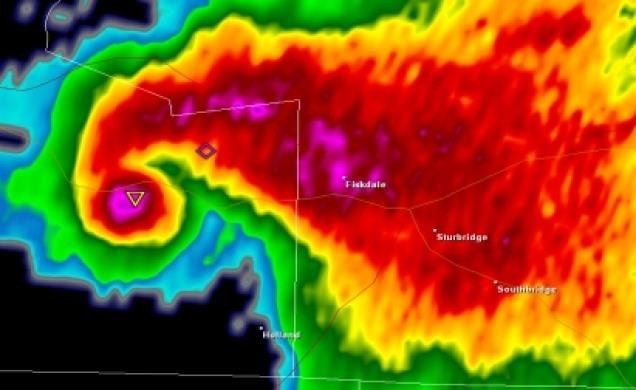-
Posts
78,751 -
Joined
-
Last visited
Content Type
Profiles
Blogs
Forums
American Weather
Media Demo
Store
Gallery
Everything posted by weatherwiz
-
This is a terrible post, mostly in part because of the last sentence. First off, since day 1 the right side of the NHC cone was of the eastern Florida coast. In terms of having Ian go off the coast and hitting SC/NC early on they didn't have that (or anyone) because there was no reason to do so and this was looking well into the longer range on the forecasting side. The range of the cone always indicated this was a possibility.
-
Plus if people are going to base such a decision because of a past experience that's just foolish on their part.
-
Yup. ERC's are very difficult. Where there has been enough research conducted to build a fundamental understanding and knowledge of what these mean for storms, forecast models don't handle those processes very well...and it has nothing to do with models "being bad"...they just aren't sophisticated enough yet to derive the processes. While we may see one is occurring and can draw conclusions there really is no way to say, "this is def going to be cat 4 or cat 5".
-
One big problem is the general public wants absolutes and don't care about the "probability" and don't even understand how probability works to begin with.
-
Yeah when I woke up this morning and saw it had only weakened to 65 mph and how Ian still looked I felt more confident this would become hurricane again over the open waters.
-
As we've seen the last several years there is not much you can do sometimes when it comes to intensity. Now model intensity guidance had been very aggressive in this becoming a category 4 hurricane but as we got closure there actually became a bit more in the way of spread regarding this and for good measures. 1) There was still the potential for a farther north track. The idea was this was it would encounter more shear and dry air which would disrupt the structure and in this scenario we saw the potential for a stall in which upwelling could eventually disrupt too. 2) There was the idea of a stronger storm if it tracked farther south and east but again, the uncertainties regarding the more northerly track yielded some hesitation with this. After the fact, it's always easy to go back and "Monday morning QB" but it's also great to go back and learn. Was the idea of the shear/dry air being overstated here? At the end of the day there really is no way to know that until you get to a certain point. But looking back, when Ian left Cuba with an incredible structure still intact and the eye rapidly becoming more symmetrical and the while structure becoming as organized as it did...it should have became very apparent shear/dry air was going to be a non-factor. Perhaps there was a shot dry air could have been a factor when the ERC was occurring, however, given the ERC meant little change in structure then it should have became apparent. We've seen this with past monsters when dry air was a concern. Once a tropical system is fully mature and well organized with its structure and features it becomes very difficult to ingest the dry air. By this point the degree of rising motion and condensation is too much. There really was no way for Ian to ingest dry air into its center. Also, I saw someone post this from Twitter but the orientation of the ULJ (despite it's strength) was one which favored enhanced upper-level divergence and probably further aided in strengthening.
-
Wow TS winds extending outwards of 415 miles from the center per latest discussion. That's insane
-
Yeah I imagine the damage there is likely quite significant...not to mention no power. They probably couldn't even get a staff to open if they wanted too.
-
I don't think so. It updated not long ago with the extension to the 7th. It was scheduled to re-open tomorrow at noon I think.
-
https://nasstatus.faa.gov/
-
Wow...looks like RSW is now closed through Oct. 7 (with some exceptions).
-
Not too surprising the western side was strongest. Even since the weekend the models indicated the strongest winds were going to be on the west side. Obviously something that may helped too is the eye was so big that while the eastern eye wall was moving onshore the system was able to remain steady-state (or slightly intensify) as it was able to continue feeding in warm/moist air.
-
The backend may even be stronger
-
Power outages skyrocketing now. U p to 450K. That's a couple hundred thousand in the last hour I think
-
Yeah there's definitely support for this. Very terrifying. Even more terrifying that Ian continues to show signs of strengthening. With the eye so large too, even when a part of the eye gets over land he may still be able to ingest enough warm/moist air to maintain cat 4/5 longer than usual or even continue with the strengthening signal for a time.
-
I just found that too That's a bit out of my area of knowledge but I would think there would be some reduction of wind over land, however, in this case I don't think it really matters. I mean when talking about winds of this magnitude is there really much of a difference?
-
Holy crap...I hope that is just some sort of error.
-
Wow highest I’ve found yet. I think this is about 8K or so
-
Looks like another robust uptick in convection too over the past 15-30 minutes on the northern and western eyewall.
-
Despite the degree of dry air around there doesn’t appear to be any indications (at least from wager vapor imagery alone) of dry air wrapping into the hurricane at all. Given how healthy Ian is it’s very possible the dry air around it does not impact much.
-
Tat one supercell in Miami-Dade/Monroe County is pretty intense looking. That is some pretty strong rotation. If cells can remain discrete like this moving through the next several hours the tornado potential is going to ramp up pretty quickly. Now as the llvl jet strengthens you start to worry about shear becoming too strong with not enough CAPE present but 3km CAPE is around 200 J which is pretty hefty. Thankfully these two seem to be in somewhat rural areas but the HRRR shows some pretty intense storms around Miami this evening.
-
This latest burst of convection on the western side of the eye wall looks to be producing the coldest cloud top temperatures yet. Just eyeballing from the scale but looks like cloud tops probably approaching or even exceeding -80°C.
-
Eye completely wrapped in convection now. Quite the explosion of lighting on all sides in the last 30-minutes (if that)
-
Starting to see convection and lightning increasing in the southern eyewall now too.
-
The improvements with the eye over the past even 30-minutes alone is quite noteworthy. Clearing out quite nicely and trying to become more symmetrical by the (satellite) update.






